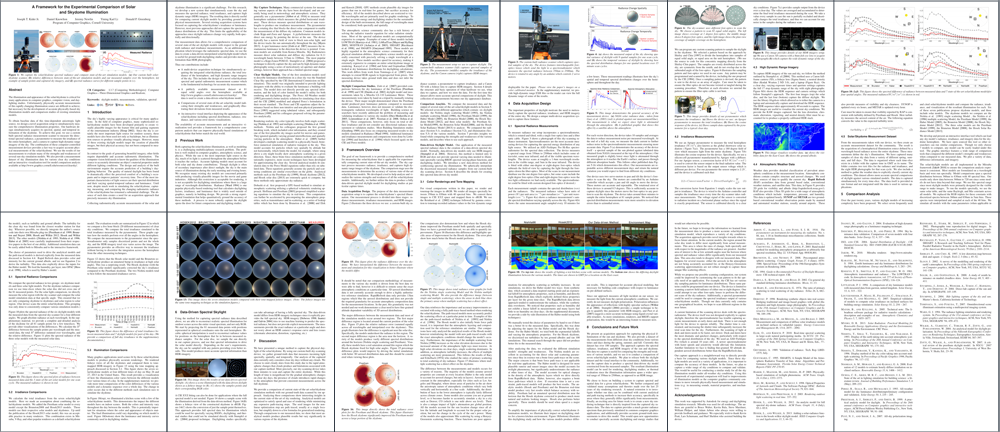SIGGRAPH Asia 2014 Paper- A Framework for the Experimental Comparison of Solar and Skydome Illumination
One of the projects I worked on in my first year as part of Cornell University’s Program of Computer Graphics has been published in the November 2014 issue of ACM Transactions on Graphics and is being presented at SIGGRAPH Asia 2014! The paper is “A Framework for the Experimental Comparison of Solar and Skydome Illumination”, and the team on the project was my junior advisor Joseph T. Kider Jr., my lab-mates Dan Knowlton and Jeremy Newlin, myself, and my main advisor Donald P. Greenberg.
The bulk of my work on this project was in implementing and testing sky models inside of Mitsuba and developing the paper’s sample-driven model. Interestingly, I also did a lot of climbing onto the roof of Cornell’s Rhodes Hall building for this paper; Cornell’s facilities was kind enough to give us access to the roof of Rhodes Hall to set up our capture equipment on. This usually involved Joe, Dan, and myself hauling multiple tripods and backpacks of gear up onto the roof in the morning, and then taking it all back down in the evening. Sunny clear skies can be a rare sight in Ithaca, so getting good captures took an awful lot of attempts!
Here is the paper abstract:
The illumination and appearance of the solar/skydome is critical for many applications in computer graphics, computer vision, and daylighting studies. Unfortunately, physically accurate measurements of this rapidly changing illumination source are difficult to achieve, but necessary for the development of accurate physically-based sky illumination models and comparison studies of existing simulation models.
To obtain baseline data of this time-dependent anisotropic light source, we design a novel acquisition setup to simultaneously measure the comprehensive illumination properties. Our hardware design simultaneously acquires its spectral, spatial, and temporal information of the skydome. To achieve this goal, we use a custom built spectral radiance measurement scanner to measure the directional spectral radiance, a pyranometer to measure the irradiance of the entire hemisphere, and a camera to capture high-dynamic range imagery of the sky. The combination of these computer-controlled measurement devices provides a fast way to acquire accurate physical measurements of the solar/skydome. We use the results of our measurements to evaluate many of the strengths and weaknesses of several sun-sky simulation models. We also provide a measurement dataset of sky illumination data for various clear sky conditions and an interactive visualization tool for model comparison analysis available at http://www.graphics.cornell.edu/resources/clearsky/.
The paper and related materials can be found at:
- Project Page (Preprint paper, supplemental materials, and SIGGRPAGH Asia materials)
- Official Print Version (ACM Library)
Joe Kider will be presenting the paper at SIGGRAPH Asia 2014 in Shenzen as part of the Light In, Light Out Technical Papers session. Hopefully our data will prove useful to future research!
Addendum 2017-04-26
I added a personal project page for this paper to my website, located here. My personal page mirrors the same content found on the main site, including an author’s version of the paper, supplemental materials, and more.
